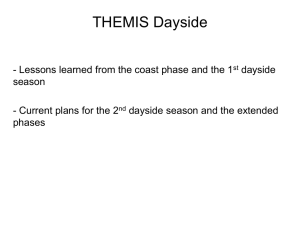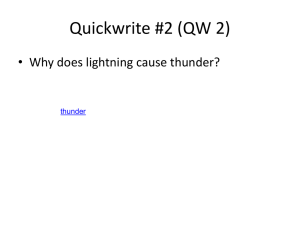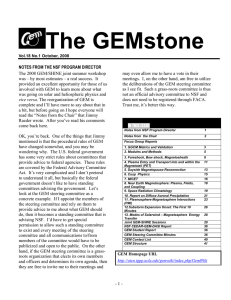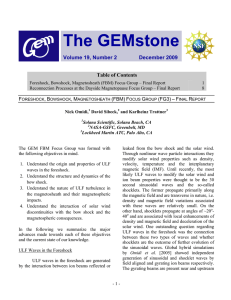Kinetic processes on the order of ion and electron scales... Dayside kinetic processes in global solar wind-magnetosphere interaction (1) Topic
advertisement
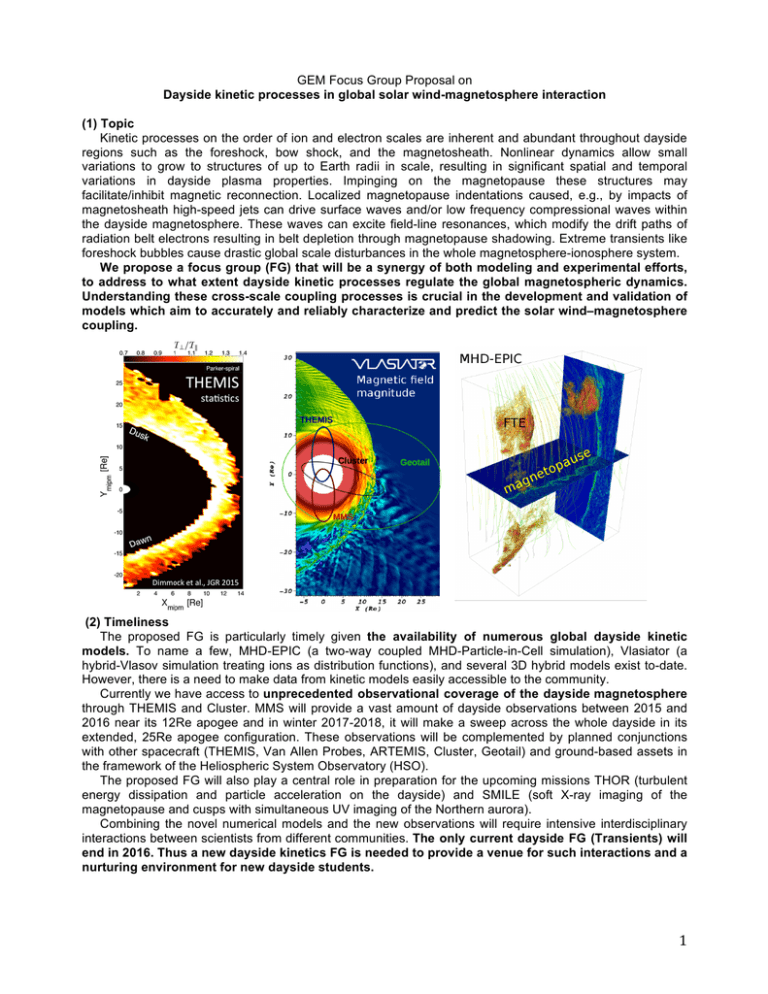
GEM Focus Group Proposal on Dayside kinetic processes in global solar wind-magnetosphere interaction (1) Topic Kinetic processes on the order of ion and electron scales are inherent and abundant throughout dayside regions such as the foreshock, bow shock, and the magnetosheath. Nonlinear dynamics allow small variations to grow to structures of up to Earth radii in scale, resulting in significant spatial and temporal variations in dayside plasma properties. Impinging on the magnetopause these structures may facilitate/inhibit magnetic reconnection. Localized magnetopause indentations caused, e.g., by impacts of magnetosheath high-speed jets can drive surface waves and/or low frequency compressional waves within the dayside magnetosphere. These waves can excite field-line resonances, which modify the drift paths of radiation belt electrons resulting in belt depletion through magnetopause shadowing. Extreme transients like foreshock bubbles cause drastic global scale disturbances in the whole magnetosphere-ionosphere system. We propose a focus group (FG) that will be a synergy of both modeling and experimental efforts, to address to what extent dayside kinetic processes regulate the global magnetospheric dynamics. Understanding these cross-scale coupling processes is crucial in the development and validation of models which aim to accurately and reliably characterize and predict the solar wind–magnetosphere coupling. (2) Timeliness The proposed FG is particularly timely given the availability of numerous global dayside kinetic models. To name a few, MHD-EPIC (a two-way coupled MHD-Particle-in-Cell simulation), Vlasiator (a hybrid-Vlasov simulation treating ions as distribution functions), and several 3D hybrid models exist to-date. However, there is a need to make data from kinetic models easily accessible to the community. Currently we have access to unprecedented observational coverage of the dayside magnetosphere through THEMIS and Cluster. MMS will provide a vast amount of dayside observations between 2015 and 2016 near its 12Re apogee and in winter 2017-2018, it will make a sweep across the whole dayside in its extended, 25Re apogee configuration. These observations will be complemented by planned conjunctions with other spacecraft (THEMIS, Van Allen Probes, ARTEMIS, Cluster, Geotail) and ground-based assets in the framework of the Heliospheric System Observatory (HSO). The proposed FG will also play a central role in preparation for the upcoming missions THOR (turbulent energy dissipation and particle acceleration on the dayside) and SMILE (soft X-ray imaging of the magnetopause and cusps with simultaneous UV imaging of the Northern aurora). Combining the novel numerical models and the new observations will require intensive interdisciplinary interactions between scientists from different communities. The only current dayside FG (Transients) will end in 2016. Thus a new dayside kinetics FG is needed to provide a venue for such interactions and a nurturing environment for new dayside students. 1 (3) Fit The dayside kinetics FG will build on the knowledge and experience gained by Transient Phenomena at the Magnetopause and Bow Shock and Their Ground Signatures (→ 2016), and utilize them when analyzing the new simulations and observations. Close coordination during the overplapping year (2016) will ensure a smooth transition and continuity of activities. The proposed FG will have many synergistic activities with the Reconnection in the Magnetosphere (→ 2017), providing a natural venue to discuss the effects of solar wind transients, foreshock and magnetosheath dynamics on dayside reconnection as well as the magnetospheric effects of reconnection generated structures. In addition, the proposed FG will complement the modeling activities of several other FGs. (4) Goal & Deliverable Broad goals of the focus group are to contribute to the understanding of (including but not limited to): • Bow shock and foreshock dynamics: particle acceleration in foreshock transients; effect of foreshock transients on bow shock structure and their transmission downstream • Magnetosheath: propagation of meso-scale variations such as high speed jets and filamentary density structures; reconnection in turbulence; waves generated by instabilities and FTEs • Response of magnetopause processes to upstream variations: reconnection, surface waves, and Kelvin-Helmholtz vortices • Response of the dayside inner-magnetosphere: excitation of waves; radiation belt effects The deliverables include: • Database of spacecraft conjunctions under different solar wind conditions providing both the coverage and the suitable observational data products (fields, particle distribution functions) for validation of current and future global kinetic models. • Modelling challenge: Events Comparison of different models with multi-point observations from MMSera events chosen by the community. The results will put the novel observations into global context. • Modelling challenge: Statistics Dayside dynamics in 2D and 3D kinetic and MHD models under different upstream conditions (IMF angle, solar wind velocity) and season (dipole tilt). The results will be compared with observational statistics. This challenge will reveal how similar/different the results are for the different approximations, and point ways to improved future models. (5) Co-chairs Heli Hietala, University of California, Los Angeles (heli[a]igpp.ucla.edu) expertise: bow shock processes, reconnection, radiation belt effects, Vlasiator simulations Xochitl Blanco-Cano, Universidad Nacional Autónoma de México (xbc([a]geofisica.unam.mx) expertise: foreshock dynamics, hybrid simulation–observation comparisons Gabor Toth, University of Michigan (gtoth[a]umich.edu) expertise: magnetospheric simulations, MHD-EPIC simulations Andrew Dimmock, Aalto University (andrew.dimmock[a]aalto.fi) expertise: bow shock dynamics, magnetosheath statistics (6) Research Area: Solar Wind Magnetosphere Interaction (SWMI) and Global System Modeling (GSM) (7) Term: Five years (2016-2020) (8) Expected activities During the first years we will have coordinated activities with the Transients FG and the Reconnection FG on linking local, conjugate dayside observations to global dynamics via simulations. In the run-up to the MMS extended-configuration dayside season we will discuss optimal data acquisition strategies, informed by numerical models, joint with HSO activities. In 2018 we will collect the first observations from this phase. The two modeling challenges will run in parallel. The common starting point is a single, short time interval with constant solar wind conditions matching an observed spacecraft conjunction. Towards the end of the FG the Events challenge will proceed to actual storms and solar wind discontinuities. The Statistics challenge has more emphasis on model-model comparisons, and the in situ validation will be against observational statistics, first from THEMIS/Cluster and then from MMS. As a part of the modeling challenges we will agree on a road map to make the data from kinetic models available and accessible to the community. Towards 2020 we will discuss how to achieve kinetic physics in operational space weather models. 2
